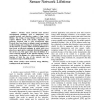Free Online Productivity Tools
i2Speak
i2Symbol
i2OCR
iTex2Img
iWeb2Print
iWeb2Shot
i2Type
iPdf2Split
iPdf2Merge
i2Bopomofo
i2Arabic
i2Style
i2Image
i2PDF
iLatex2Rtf
Sci2ools
JNW
2007
2007
The Effect of Physical Topology on Wireless Sensor Network Lifetime
— Wireless sensor networks must measure environmental conditions, such as temperature, over extended periods and therefore require a long system lifetime. The design of long lifetime networks in turn requires efficient sensor node circuits, algorithms, and protocols. Protocols such as GSP (Gossip-based Sleep Protocol) have been shown to mitigate energy consumption in idle listening and receiving, by turning off the receiver circuit. However, previous studies of network lifetime have been based on physical topologies in which nodes were placed on a square grid or randomly distributed throughout the service area. This paper shows that the lifetime of a sensor network depends on the physical topology of the sensor nodes. The lifetime of a sensor network varies as a function of both the size of the network and the transmission range of individual nodes.
| Added | 15 Dec 2010 |
| Updated | 15 Dec 2010 |
| Type | Journal |
| Year | 2007 |
| Where | JNW |
| Authors | Debdhanit Yupho, Joseph Kabara |
Comments (0)

